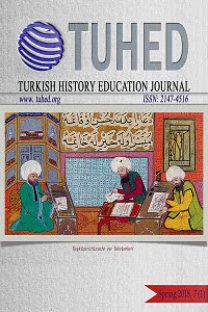Efforts to create an erroneous perception in historiography: The case of Stefan Ihrig
Efforts to create an erroneous perception in historiography: The case of Stefan Ihrig
Although history is a science based on concrete documents and information in the study of the past, it has started to be used as a tool of political powers, power centers, and groups who want to gain benefits by creating perceptions. As a result of the falsification of concrete facts, popularized history has started to replace real history and manipulate social perceptions. Dozens of popular historiographies create erroneous perceptions about the Turkish nation. These include the Blue Book, which portrays the 1915 events as the Armenian genocide, George Horton's "The Scourge of Asia", which claims that the Great Smyrna Fire was started by the Turks, and Margaret Housepian Dobkin's "Smyrna 1922: The Destruction of a City". One of these is Stefan Ihrig's "Atatürk in the Nazi Imagination". Immediately after the publication of the book by Harvard University Press, newspapers close to the Nazi Party and speeches of politicians within the party began to emphasize the admiration of the Nazis and Hitler for Atatürk, and it was discussed that Hitler took Atatürk as a role model. In particular, the book, which attempted to draw similarities between the Armenian deportation and the Holocaust, was also adopted and supported by some publications supporting the Armenian claims in order to strengthen the "so-called Armenian Genocide" allegations. This study aims to demonstrate the use of popular historiography as a method to create erroneous perceptions of societies by taking the book "Atatürk in the Nazi Imagination" by Stefan Ihrig as an example.
Keywords:
popular historiography, erroneous perception, Atatürk, Stefan İhrig, Armenian question Hitler and Nazis,
___
- Avcı, E. (2019). Popüler tarihçilik bağlamında nevzat kösoğlu’nun eserlerindeki tarih anlayışı ve tarih eğitimine ilişkin görüşleri (Unpublished Master Thesis). Sakarya Üniversitesi SBE, Sakarya.
- Başbuğ, İ. (2015). Ermeni suçlamaları ve gerçekler. Ankara: Remzi.
- Berger, S. (2012). Professional and popular historians 1800-1900-2000. Popular History Now and Then, pp. 13-31.
- Coleman, B. (2006). George Horton: the literary diplomat. Byzantine and Modern Greek Studies, 30, pp. 81-93.
- Gürün, K. (2012). Ermeni dosyası. İstanbul: Rüstem.
- Haydn, T. (2015). History magazines in the UK. S. Popp. Commercialized History: Popular History Magazines in Europe, pp. 275-295.
- Hitler, A. (2017). Kavgam (Mein Kampf). Ankara: Parga.
- Horton, G. (1926). The Blight of Asia, an account of the systematic extermination of Christian populations by Mohammedans and of the culpability of certain great power, by with the true story of the burning of Smyrna. USA: The Bobbs-Merrill Company.
- Housepian, M. (2015). İzmir 1922: Bir kentin yıkımı (A. Tuygan, Trans.). İstanbul: Belge.
- Ihrig, S. (2014). Atatürk ın the Nazi imagination . Cambridge: Harvard University.
- Kaplan, H. (2014, Aralık 1). Hitler`in rol modeli Atatürk. Ermeni Haber. Retrieved from (03.17.2023): https://www.ermenihaber.am/tr/news/2014/12/01/Hilal-Kaplan-Hitler%E2%80%99in-rol-modeli-Atat%C3%BCrk/25291.
- Oğur, Y. (2014, Kasım 30). Karanlıkta parıldayan yıldız. Türkiye Gazetesi. Retrieved from (03.17.2023): https://www.turkiyegazetesi.com.tr/ kose-yazilari/yildiray-ogur/karanlikta-parildayan-yildiz-583563.
- Paletschek, S. (2011). Popular presentations of history in the nineteenth century: The example of Die Gartenlaube. S. Paletschek. S. Paletschek (Ed.), Popular Historiographies In the 19th and 20th Centuries, pp. 34-54. Berghahn Books.
- Şahin, E. (2023). Bir Ermeni propaganda klasiği: “Mavi Kitap (Blue Book)”. Retrieved from (03.18.2023): https://turksandarmenians.marmara.edu.tr/tr/bir-ermeni-propaganda-klasigi-mavi-kitap-blue-book
- Thorp, R. (2015). Popular history magazines and history. Historical Encounters: A Journal of Historical Consciousness, Historical Cultures, and History Education, 2(1), pp. 102-112.
- Uygun, İ. (2014). Cumhuriyet dönemi tarihi romanları 1923-1946 : "Eski" Kahramanların Yeni Söylemler. Ankara: Bilkent Üniversitesi Türk Edebiyatı Department.
- ISSN: 2147-4516
- Yayın Aralığı: Yılda 2 Sayı
- Başlangıç: 2012
- Yayıncı: Ahmet Şimşek
Sayıdaki Diğer Makaleler
Malazgirt Savaşı’nın popüler tarihçiliğe yansımaları: Cumhuriyet gazetesi örneği
Efforts to create an erroneous perception in historiography: The case of Stefan Ihrig
İlmi ziyaretlerin milli terbiyemizde yeri (Y. Z. Aktaş, Çev.)
A comparative analysis of the curriculum implemented in the village institutes
